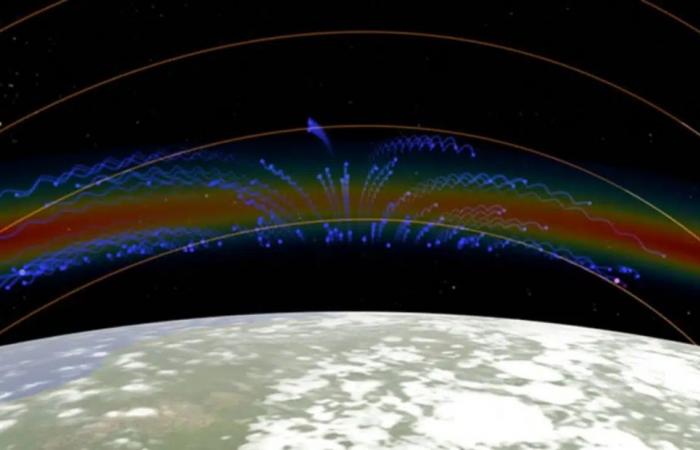NASA’s Global-scale Observations of the Limb and Disk (GOLD) mission has discovered fascinating C- and X-shaped features in the ionosphere, a region of Earth’s upper atmosphere that extends from about 30 to 600 miles (48 to 965 kilometers) above the surface.
These surprising findings could have significant implications for our understanding of space weather and its impact on communications and navigation systems. The ionosphere is a fundamental part of the Earth’s atmosphere, playing a crucial role in the transmission of radio waves and influencing global communication systems. This layer becomes electrically charged during the day when solar radiation ionizes atmospheric particles, creating a plasma composed of free ions and electrons. These charged particles are influenced by the Earth’s magnetic field, forming plasma bands and various dynamic structures. During the night, the density of the ionized particles decreases, creating low-density pockets known as plasma bubbles. These plasma formations can have a significant impact on the propagation of radio waves, making the ionosphere a key area of study for understanding and predicting space weather phenomena. The GOLD mission, launched to study the behavior of the ionosphere, provided unprecedented images of C- and X-shaped plasma formations. Previous observations of such structures were typically associated with significant geomagnetic events, such as solar storms or volcanic eruptions, which disturb the magnetic environment. However, recent data from GOLD reveal that these shapes can also form during periods of geomagnetic calm, suggesting the involvement of more localized atmospheric factors. Fazlul Laskar, an ionospheric physicist at the University of Colorado, commented: “Early reports of mergers were only during geomagnetic disturbance conditions. It is an unexpected feature during geomagnetic quiet conditions.” This discovery indicates that the mechanisms underlying plasma formation and behavior in the ionosphere are more complex than previously thought. One of GOLD’s most intriguing discoveries is the discovery of C-shaped and inverse-C-shaped plasma bubbles. These shapes are thought to be created by winds on Earth, just as wind directions can shape the growth of trees. The GOLD mission provided high-resolution images revealing these C-shaped structures forming surprisingly close together, sometimes within 634 kilometers (400 miles) of each other. Images from NASA’s Gold mission show C-shaped and inverted-C-shaped plasma bubbles, very close together, in the ionosphere. This proximity suggests that localized atmospheric factors, such as wind shear, small-scale atmospheric disturbances, or even tornado-like phenomena, could influence their formation.
“Within that close proximity, these two oppositely shaped plasma bubbles have never been thought of, never imagined,” said Deepak Karan, an ionospheric physicist at the University of Colorado. Tightly packed C-shaped bubbles appear to be relatively rare, with only two observed by GOLD so far, but their presence in close proximity indicates complex atmospheric dynamics at play. Plasma structures in the ionosphere play a critical role in the reflection and refraction of radio waves, enabling long-distance communications. Disruptions in the ionosphere, such as the recently observed C- and X-shaped features, can interfere with these signals, causing communications blackouts and navigation errors in GPS systems. The ability to understand and predict these disturbances is critical to the reliability of communications and navigation infrastructures. Deepak Karan of the University of Colorado emphasized the novelty and significance of these findings: “Within that close proximity, these two oppositely shaped plasma bubbles have never been thought of, never imagined.” These observations could lead to improved models of ionospheric behavior, improving the accuracy of space weather forecasts and mitigating the impact on technological systems. The discovery of these unusual plasma shapes underscores the importance of continuous monitoring and advanced imaging technologies in atmospheric research. The high-resolution data from the GOLD mission are critical to refining our understanding of ionospheric dynamics. Future research will focus on identifying the specific atmospheric conditions that lead to the formation of these structures, whether it is wind shear, localized atmospheric disturbances, or other factors. Jeffrey Klenzing of NASA’s Goddard Space Flight Center in Greenbelt, N.J., noted, “The fact that we have very different shapes of bubbles so close together tells us that the dynamics of the atmosphere are more complex than we expected.” This research will not only improve our understanding of Earth’s upper atmosphere, but will also improve the reliability of communications and navigation systems affected by space weather. The findings, published in The Journal of Geophysical Research: Space Physics, highlight how technological advances in observational instruments like GOLD are expanding our knowledge of the ionosphere. As NASA continues to monitor and study these phenomena, the information gained will contribute to better space weather forecasting, ensuring the stability and reliability of critical infrastructure on Earth.



